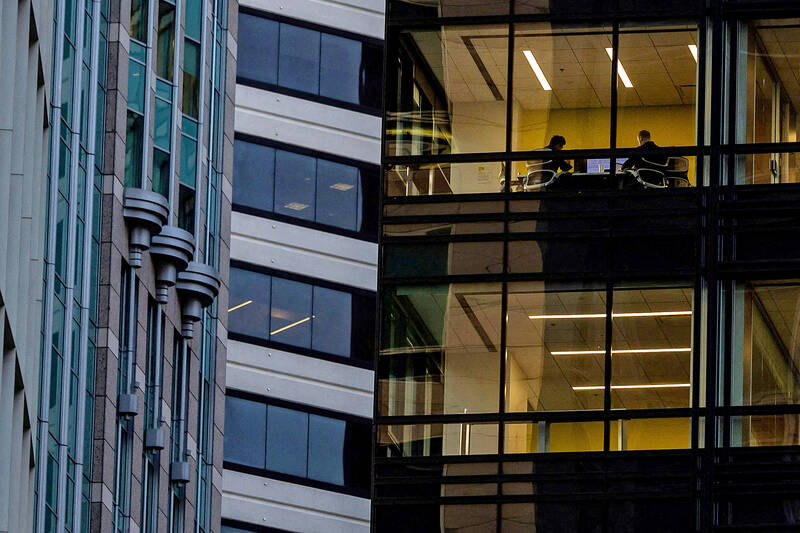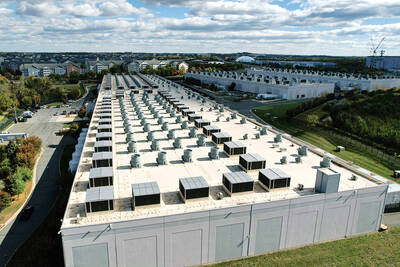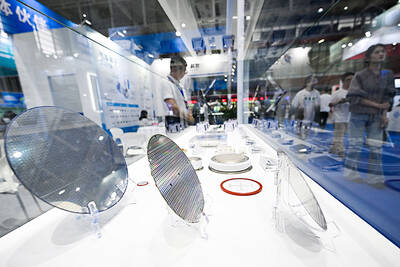A US banking giant fired more than a dozen employees for “simulating keyboard activity,” highlighting a battle within productivity-obsessed corporate America to tame a culture of faking work with gizmos such as mouse jigglers.
The sackings by Wells Fargo & Co come as employers use sophisticated tools — popularly called “tattleware” or “bossware” — on company-issued devices to monitor productivity in the age of hybrid work that took off after the COVID-19 pandemic.
Some workers seek to outsmart them with tools such as mouse movers — which simulate cursor movement, preventing their devices from going into sleep mode and making them appear active when they might actually be taking a power nap or doing laundry.

Photo: Reuters
The cat-and-mouse game has spurred a wider debate in corporate America about whether screen time and the click-clacking of keyboards are effective yardsticks to measure productivity amid a boom in remote work.
The Wells Fargo workers were dismissed last month following a probe of allegations involving “simulation of keyboard activity creating impression of active work,” Bloomberg reported, citing the company’s disclosures to financial regulators.
Wells Fargo “holds employees to the highest standards and does not tolerate unethical behavior,” the company said in a statement, without elaborating.
Multiple US surveys show that demand for employee monitoring software — systems that track activity through desktop monitoring, keystroke tracking and even GPS location — has shot up since the pandemic.
One Florida-based social media marketing company installed software on employees’ devices that took screenshots of their desktop every 10 minutes, Harvard Business Review (HBR) reported.
Such surveillance has given rise to what human resource professionals call “productivity theater” — in which some employees seek to project that they are busy while doing nothing constructive.
A series of “tutorials” on platforms including TikTok and YouTube offer instruction on how to appear busy on computer screens, which generally go black after a few minutes of inactivity.
Those include fake PowerPoint techniques for “when you need to take your afternoon nap.”
“Just hit ‘slideshow’ and you’re good,” Sho Dewan, an influencer who identifies himself as an “ex-recruiter sharing HR [human resources] secrets,” said in a TikTok video that garnered millions of views.
The device would stay “active” while the presentation is on, he said flashing a thumbs up before a slide that read: “Really important work meeting.”
Among the hundreds of comments under the video, one viewer quipped: “At one point I taped a mouse to an oscillating fan — why couldn’t I have found [this] sooner?”
Another trick included in the tutorials involves opening a notes application and placing a lock on any keyboard letter. The worker thereby appears active to tracking devices while the page fills up with row after row of the same letter.
The most popular trick appears to be the deployment of mouse jigglers, widely available on Amazon for as little as US$11.
“Push the button when you’re getting up from your desk and the cursor travels randomly around the screen — for hours, if needed,” one product review on Amazon reads.
However, there remains a serious risk of getting caught.
In one viral Reddit post titled “My manager caught me with a mouse jiggler,” an employee said that the transgression was the “last straw” after he excused himself from several meetings citing “power outages” and “thunderstorms.”
He noted that he had installed a software-based jiggler, prompting some readers to suggest using “non detectable” physical ones.
HR professionals warn of the dangers of surveilling employees and confusing keyboard activity with productivity.
One survey cited by HBR suggested that secretly monitoring employees can “seriously backfire.”
“We found that monitored employees were substantially more likely to take unapproved breaks, disregard instructions, damage workplace property, steal office equipment and purposefully work at a slow pace,” the HBR report said.
A.J. Mizes, chief executive of the consulting firm Human Reach, said the use of mouse jigglers demonstrated a “work culture driven by metrics rather than meaningful productivity and human connection.”
“There has been a growing troubling trend of excessive surveillance in corporate America,” Mizes said. “Rather than stirring up innovation and trust, this surveillance approach will only push employees to find additional ways to appear busy.”

Taiwan’s exports soared 56 percent year-on-year to an all-time high of US$64.05 billion last month, propelled by surging global demand for artificial intelligence (AI), high-performance computing and cloud service infrastructure, the Ministry of Finance said yesterday. Department of Statistics Director-General Beatrice Tsai (蔡美娜) called the figure an unexpected upside surprise, citing a wave of technology orders from overseas customers alongside the usual year-end shopping season for technology products. Growth is likely to remain strong this month, she said, projecting a 40 percent to 45 percent expansion on an annual basis. The outperformance could prompt the Directorate-General of Budget, Accounting and

The demise of the coal industry left the US’ Appalachian region in tatters, with lost jobs, spoiled water and countless kilometers of abandoned underground mines. Now entrepreneurs are eyeing the rural region with ambitious visions to rebuild its economy by converting old mines into solar power systems and data centers that could help fuel the increasing power demands of the artificial intelligence (AI) boom. One such project is underway by a non-profit team calling itself Energy DELTA (Discovery, Education, Learning and Technology Accelerator) Lab, which is looking to develop energy sources on about 26,305 hectares of old coal land in

Netflix on Friday faced fierce criticism over its blockbuster deal to acquire Warner Bros Discovery. The streaming giant is already viewed as a pariah in some Hollywood circles, largely due to its reluctance to release content in theaters and its disruption of traditional industry practices. As Netflix emerged as the likely winning bidder for Warner Bros — the studio behind Casablanca, the Harry Potter movies and Friends — Hollywood’s elite launched an aggressive campaign against the acquisition. Titanic director James Cameron called the buyout a “disaster,” while a group of prominent producers are lobbying US Congress to oppose the deal,

Two Chinese chipmakers are attracting strong retail investor demand, buoyed by industry peer Moore Threads Technology Co’s (摩爾線程) stellar debut. The retail portion of MetaX Integrated Circuits (Shanghai) Co’s (上海沐曦) upcoming initial public offering (IPO) was 2,986 times oversubscribed on Friday, according to a filing. Meanwhile, Beijing Onmicro Electronics Co (北京昂瑞微), which makes radio frequency chips, was 2,899 times oversubscribed on Friday, its filing showed. The bids coincided with Moore Threads’ trading debut, which surged 425 percent on Friday after raising 8 billion yuan (US$1.13 billion) on bets that the company could emerge as a viable local competitor to Nvidia